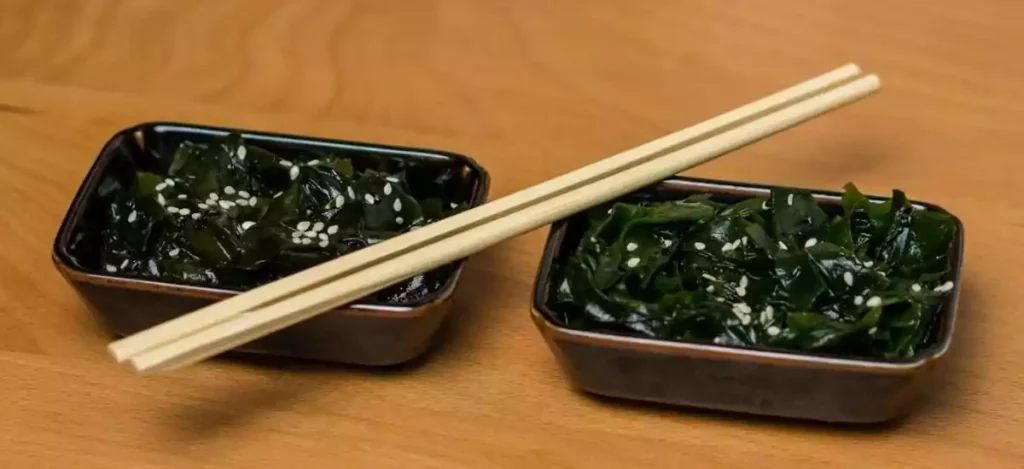Yes, seaweed salad can go bad! But with the proper process of refrigeration, you may keep the seaweed salad that you just made in the refrigerator for up to three or four days.
Still, if you dry it and put it in an airtight container, it will remain delicious even after being preserved for many years. Be till the end to know the best ways to keep your seaweed salad healthy and fresh.
In this article, you will get various ways to know the long time to keep seaweed salad and how to recognize a rotten salad before having it to avoid serious health issues.
Elucidation Of Seaweed Salad?

In Japan, a meal known as seaweed salad is quite common. Most restaurants offer it as a starter or a side dish. It is prepared using various kinds of seaweed and is topped with a sauce with sweet and salty flavors.
This meal uses toasted sesame, wood ear mushrooms, and sweet bell peppers as its constituent parts. The seaweed salad is held together using agar-agar that has been added to it.
Also Refer: can you freeze cocktail sauce
This company’s forte is in preparing meals that include a wide variety of fish and shellfish. Goma Wakame is a species of seaweed that, after being cooked, has a delicious flavor. Either chopsticks or forks will work for eating this dish. It pairs well with sushi.
Seaweed that may be eaten is a source of nutrition for humans and other marine species. People may also absorb iodine from the ocean via this method. One form of plant that thrives in aquatic environments is known as seaweed.
It is loaded with a wide variety of vitamins and minerals. In addition to having extremely few calories, it has a long history of consumption in Asia.
How Long Does Seaweed Salad Last?
Seaweeds are plants that can be eaten that may be found growing in waters. Salads often start with them as their foundational component. If you put your seaweed salad in the refrigerator, it will keep for a longer period. To enjoy their full flavor, you should consume them within the first four hours after purchasing them.
Containers with lids that can be securely fastened should be used to preserve seaweed salads. Keeping the cover off the salad container but opening it up regularly can help keep it from turning bad.
Refrigeration is required for seaweed salads to maintain their freshness. After six months, the taste of seaweed salad that has been frozen will be diminished. Putting seaweed salad that has been thawed in the refrigerator is not recommended.
How Can You Tell If Seaweed Salad Is Bad?
A seaweed salad is at its crunchiest and has the most delightfully airy flavor when kept nice and fresh. It will eventually become limp and have a flavor similar to vinegar, at which point it has to be thrown out since it has turned.
Signs Of Bad Seaweed Salad
- Once the seaweed has deteriorated, its consistency changes to become sticky and slimy. It often occurs when the item is subjected to high temperatures over extended periods.
- When freshly prepared seaweed salad, there is hardly any discernible odor. However, as it begins to change, it will begin to emit a very recognized smell.
- A seaweed salad is at its crunchiest and has the most delightfully airy flavor when kept nice and fresh. It will eventually become limp and have a flavor similar to vinegar, at which point it has to be thrown out since it has turned.
- The seaweed will begin to change color and experience a texture shift. It may become more of a brown or yellowish tint.
- The smell of the seaweed will be quite unpleasant. Even if there isn’t a treatment for it right now, there are things that can assist.
- As it decomposes, it releases a chemical known as hydrogen sulfide into the air. Hydrogen sulfide has an extremely terrible stench, like rotten eggs. The microscopic marine critters in the Sargassum may cause rashes and blisters on your skin.
- Trimethylaminuria, often known as TMAU, is an extremely rare disorder associated with an unpleasant fishy odor. Fish odor syndrome is another name for this condition.
- Although this is sometimes the case, it is not always the case. Sometimes it is caused by defective genes that a person receives from their parents.
Tips For Storing Seaweed Salad
Seaweed on its own has a shelf life that is adequate to meet requirements. However, when coupled with other components, seaweed salad has a shelf life that is greatly prolonged beyond what it would have been otherwise. If the seaweed salad is dried and kept correctly, it may continue to be edible for an endless period.
Took A Glance: how long is leftover chinese food good for
Even though dried seaweed does not become rancid or rot, it may lose some of its flavor and nutritional value if it is not properly kept. It is the case even though dried seaweed does not disintegrate. Once the expiration date has passed, the seasoned seaweed will no longer be used for more than one more year.

Top Tips For Storing Seaweed Salad
- It is safe to keep seaweed salad at room temperature for about four hours after it has been prepared.
- It is best to keep it in the refrigerator if you are not planning to consume it within that period.
- After being placed refrigerated, it should be good for up to four days before it begins to go bad. That is if the door of the refrigerator isn’t opened and closed an excessive amount.
- In such a case, it will probably go bad a little earlier than normal. If you store the seaweed salad in a container and continue to access it to serve a little bit, as long as you reseal it after each use, it will remain edible for around three to four days.
- The best place to keep it for a long period is in the freezer, so make sure you do that.
Can Seaweed Salad Make You Sick?
It is possible that food poisoning might be caused by eating seaweed salad, just as it could be caused by eating other fresh vegetables. In 2020, more than 3,000 schoolchildren in Japan were sick after eating seaweed salad with E.
coli in it, and it was polluted. Diarrhea and cramping in the stomach region are the hallmarks of the early stages of an E. coli infection, which may manifest themselves anywhere from two to seven days after intake.
Findings suggest that certain species of seaweed may become toxic at the end of their reproductive cycle and, as a result, exhibit a seasonal variation in the number of toxins that they produce. Even though the mechanism by which seaweed develops its toxic properties has not been conclusively determined.
Other hypothesized mechanisms include the possibility that the strain of over-harvesting could cause the seaweed to start producing toxins as a method of self-defense, as well as the idea that environmental changes and an increase in pollution could encourage the colonization of bacteria to produce toxins.
People who may consume seaweed should be informed by state and local health departments that eating it can be associated with illness and that varieties previously consumed safely may undergo changes that increase their potential for causing illness.
This information should be disseminated to people who may consume seaweed. It is important to notify state and local health officials as soon as possible about any incidents of sickness that may be linked to seaweed.
Frequently Asked Questions
1. Is It Safe To Eat Expired Seaweed?
Even beyond the expiration date, seaweed may still be consumed without risk to one’s safety or health. Seaweed, however, can be consumed without risk even if it has passed its best-before date. After the expiry date, seasoned seaweed won’t remain usable for more than one additional year.
2. How Long Does Wet Seaweed Last?
It is safe to keep seaweed salad at room temperature for about four hours after it has been prepared. It is best to keep it in the refrigerator if you are not planning to consume it within that period. In refrigeration, it should be good for up to four days before it begins to go bad.
3. Can Seaweed Salad Make You Sick?
Seaweed’s high fiber content may be beneficial to digestion, but it also has the potential to irritate the digestive tract. Because one gram of fiber adds up quickly, consuming multiple servings of seaweed each day may easily put you over the amount of fiber that is suggested for a single day. Consuming an excessive amount of fiber may result in bloating, gas, and constipation.
Have A Look At: can you freeze cocktail sauce
